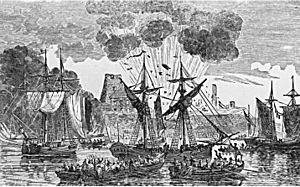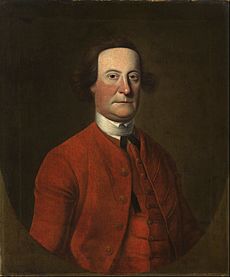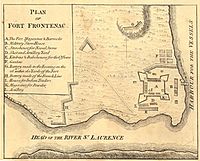Battle of Fort Frontenac facts for kids
Quick facts for kids Battle of Fort Frontenac |
|||||||
|---|---|---|---|---|---|---|---|
| Part of the Seven Years' War French and Indian War |
|||||||
 A picture of the battle by John Henry Walker |
|||||||
|
|||||||
| Belligerents | |||||||
| Commanders and leaders | |||||||
| Strength | |||||||
|
2,635
|
110 regulars 2 armed vessels |
||||||
| Casualties and losses | |||||||
| 11 wounded | 2 killed All surrendered 2 ships captured |
||||||
The Battle of Fort Frontenac happened from August 26 to 28, 1758. It was part of the Seven Years' War, which was also called the French and Indian War in North America. This battle was fought between France and Great Britain.
The battle took place at Fort Frontenac. This was a French fort and trading post located where Kingston, Ontario is today. It was at the eastern end of Lake Ontario, where the lake flows into the St. Lawrence River.
British Lieutenant Colonel John Bradstreet led an army of over 3,000 men. Most of his soldiers were militia, which are like citizen-soldiers. Only about 150 were professional regular soldiers. They surrounded the fort, which had about 110 French defenders. After two days, the French surrendered.
This victory was very important for the British. It cut off one of the main supply routes for the French. This route connected their big cities like Montreal and Quebec City to their western lands. The British also captured many valuable goods from the trading post.
Contents
Why the Battle Happened
The British had three main goals for their military actions in North America in 1758. Two of these goals were to capture Fort Louisbourg and Fort Duquesne. Both of these attacks were successful.
However, the third British plan did not go well. A large army of 16,000 men, led by General James Abercrombie, was badly defeated. This happened on July 8, 1758, at the Battle of Carillon. This fort is known today as Fort Ticonderoga. A much smaller French force defeated the British there. After this big loss, many British officers wanted to show they were not to blame.
Lieutenant Colonel John Bradstreet suggested an old idea again: to capture Fort Frontenac. This French fort and trading post was on the northern shore of Lake Ontario. It was near where the lake empties into the St. Lawrence River. General Abercrombie had first said no to this idea. He thought the troops were needed to attack Fort Carillon. But after the defeat, he approved Bradstreet's plan.
Bradstreet's plan was to move his army up the Mohawk River valley. They would go to the ruins of Fort Oswego. This fort had been captured and burned by the French in 1756. From there, they would cross Lake Ontario to attack Fort Frontenac.
Why Fort Frontenac was Important
The British thought Fort Frontenac was a serious threat. It controlled the travel and communication routes to other French forts and outposts. These were located along the St. Lawrence – Great Lakes water route and in the Ohio Valley. Even though the fort was not as important as it once was, it was still a base. Supplies for the western outposts came from Fort Frontenac.
The British believed that if they captured the fort, supplies would be cut off. Then, the French outposts would not be able to defend themselves. Also, trade with Native American tribes in the upper country would be stopped.
Fort Frontenac was also seen as a threat to Fort Oswego. The British had built Fort Oswego across the lake from Fort Frontenac in 1722. They built it to compete with Fort Frontenac for trade with Native Americans. Later, it became a military base. General Montcalm had used Fort Frontenac as a starting point to attack Fort Oswego in August 1756.
The British also hoped that taking this well-known fort would make their soldiers feel better. Their spirits were low after the defeat at Fort Ticonderoga in July 1758.
Bradstreet's March
Bradstreet gathered his army at Schenectady. It included only 135 regular soldiers. The rest were about 3,500 militia from New York, Massachusetts, New Jersey, and Rhode Island.
By the time his army reached the ruins of Fort Oswego on August 21, Bradstreet had lost 600 men. Most of them had left the army. The journey faced little resistance from French and Native American raiding parties. However, the path to Oswego had not been used much since 1756. It was overgrown, and some waterways were shallow. This made it hard for the heavily loaded boats to pass.
Bradstreet's boats crossed Lake Ontario. They landed about one mile (1.6 km) from Fort Frontenac on August 25. There was no opposition when they landed.
Fort Frontenac's Defenders
Fort Frontenac was an important trading center for Native American and French fur traders. The trade there was so good that some Native Americans preferred to trade with the French. They liked it better than trading with the British at Albany, New York. The British offered cheaper goods, but the French fort was still popular.
The fort itself was an old, crumbling stone building. It had very few soldiers. There were about 100 French troops, plus some militia and Native Americans. They were led by Pierre-Jacques Payen de Noyan et de Chavoy. He was an older soldier who had fought in King George's War.
Normally, the fort had more soldiers. But the French military leaders had to send soldiers to defend other parts of Canada. So, the fort's size was reduced. Noyan learned about the British army's approach when Native American scouts captured some prisoners. Authorities in Montreal tried to send more soldiers to help. But these extra troops would not arrive before the British attack.
The Battle Begins
The night after landing, Bradstreet's men set up their cannons. They also began to dig trenches closer to the old fort. They tried to get onto two French ships anchored near the fort, but they were not successful.
On the morning of August 26, the British cannons began to fire. The French soldiers in the fort fired back with their own cannons and muskets. But their fire did not do much damage to the British.
The two sides kept shooting at each other on August 27. The British set up more cannons to the northwest of the fort. These new cannons were only about 200 yards (180 m) from the fort.
On the morning of August 28, two French ships tried to leave the harbor. But they got stuck after the British kept firing at them. After a short meeting, Noyan decided to surrender. He raised the white flag.
After the Battle
When the British captured Fort Frontenac, they took many important supplies. These supplies were meant for French forts in the Ohio Country. The British found more than 60 cannons. Some of these were British cannons that the French had captured at Fort Oswego earlier. They also found hundreds of barrels of food.
For the many militia soldiers in Bradstreet's army, the most exciting discovery was many bundles of furs. These furs were going to be sent downriver to Montreal. All together, the captured goods were worth a lot of money.
Bradstreet's orders were not to keep the fort. His orders were to destroy it. So, many of the supplies were burned. The army then went back to Oswego. They used some of the captured French ships to help carry the valuable goods they had taken.
Bradstreet let the French prisoners go. Noyan promised that an equal number of British prisoners would be set free in return. The French soldiers then started to make their way back to Montreal. They met the relief force that had been sent from Montreal to help them.
The French later set up Fort de La Présentation (where Ogdensburg, New York is today). This became a new base for supplies and defense. Fort Frontenac was lightly guarded again in 1759. But it was no longer an important place in the war. The war ended when Montreal fell to the British in September 1760.
The governor of New France, the Marquis de Vaudreuil, said he was responsible for the French loss. He had believed that the British "would not dare to enter [Lake Ontario] on which [the French] had vessels." He made Noyan retire from the army.
See also
 In Spanish: Batalla de Fort Frontenac para niños
In Spanish: Batalla de Fort Frontenac para niños



